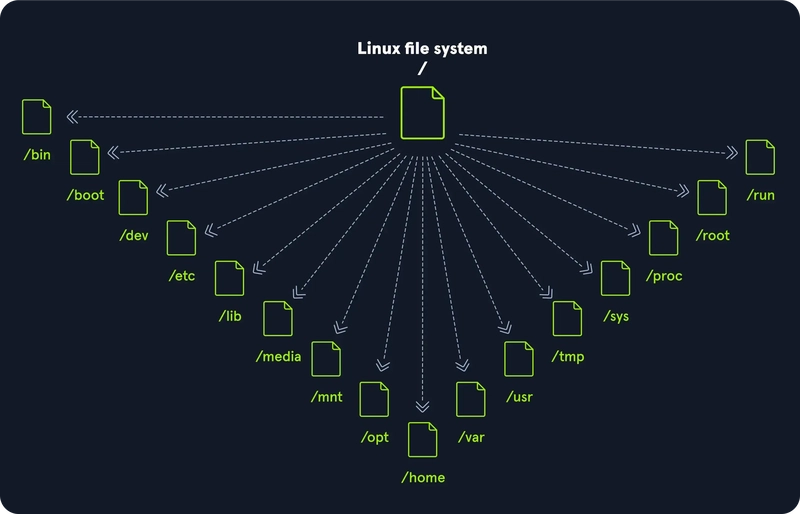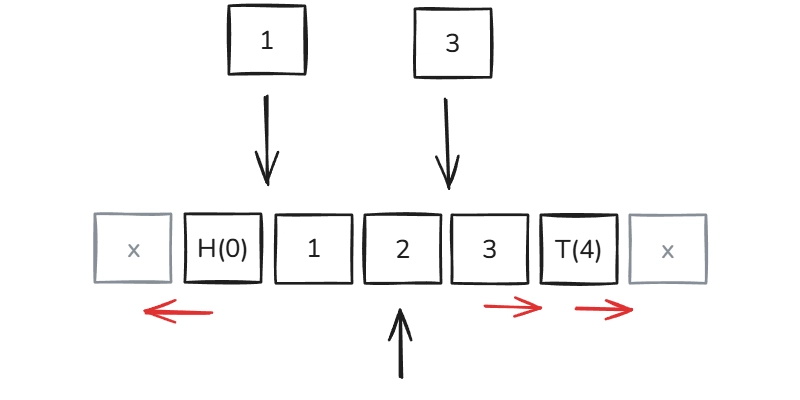Linux in Action - File Structure Hierarchy and Its Role in Modern Business
Introduction Linux is a powerful and versatile operating system that has become the backbone of many businesses and industries. Its open-source nature allows for customization and flexibility, making it an ideal choice for server management and various applications. In this article, we will explore the fundamental aspects of Linux, including its kernel, different distributions, and its file structure hierarchy. We will also explore into why Linux is preferred by tech professionals and how it empowers businesses. This content is designed to be accessible to both tech enthusiasts and those new to the world of Linux. Table of Contents Overview Linux Kernel and Distributions Linux Usage in AWS Linux and Business Empowerment Bash and System Administration DevOps with Linux Linux File Structure Hierarchy RHEL 9 and Its Industrial Use Cases Benefits of Understanding Linux Final Thoughts Overview Linux is known for its stability, security, and efficiency. At its core is a well-defined file hierarchy that lays out every file and directory in a predictable way. This structure is consistent across most Linux distributions, meaning what you learn here will apply to Ubuntu, Fedora, Arch, and more. Tip: Understanding Linux doesn’t just help with your personal project, it’s also a major plus in professional settings where Linux powers servers and cloud environments. Linux Kernel and Distributions The Linux kernel is the core component of the Linux operating system. It is responsible for managing system resources, such as the CPU, memory, and devices. The kernel acts as a bridge between the hardware and software, ensuring efficient communication and operation. There are various Linux distributions, each tailored to different needs and preferences. Some of the most popular distributions include: Ubuntu: Known for its user-friendly interface and strong community support, Ubuntu is widely used for desktops and servers. Debian: A stable and versatile distribution, Debian is favored for its robustness and extensive software repository. Fedora: Sponsored by Red Hat, Fedora is known for its cutting-edge features and rapid development cycle. CentOS: A free and open-source alternative to RHEL, CentOS is popular for enterprise environments. Red Hat Enterprise Linux (RHEL): A leading distribution in industrial settings, RHEL offers stability, security, and comprehensive support. Arch Linux: Known for its simplicity and customization, Arch Linux is preferred by advanced users who want full control over their system. SUSE Linux Enterprise: A distribution focused on enterprise solutions, SUSE provides robust support and scalability. Linux Usage in AWS Linux plays a crucial role in AWS's backend infrastructure. Many of the services offered by AWS, such as EC2 (Elastic Compute Cloud), Lambda, and ECS (Elastic Container Service), are built on Linux-based systems. Linux's open-source nature allows AWS to customize and optimize the operating system to meet specific needs, providing a robust and secure platform for cloud services. Linux and Business Empowerment Linux is a powerful operating system that has become the backbone of many businesses. Its open-source nature allows for customization and flexibility, making it an ideal choice for server management. Tech professionals prefer Linux for its stability, security, and efficiency. It supports a wide range of applications and services, making it a versatile platform for various business needs. Business Use Case: Many financial institutions use Linux to run their trading platforms and manage large-scale databases. Its stability and security features ensure that sensitive financial data is protected and transactions are processed efficiently. Bash and System Administration Bash, or the Bourne Again Shell, is a command-line interface that enables users to perform system administration tasks efficiently. With Bash, you can automate repetitive tasks, manage files, and configure system settings. It is an essential tool for system administrators, providing powerful scripting capabilities to streamline operations. Business Use Case: In the healthcare industry, Bash scripts are used to automate the processing of patient records and manage system backups. This automation helps reduce manual errors and ensures that critical data is securely stored. DevOps with Linux Linux plays a crucial role in DevOps practices, facilitating continuous integration and continuous deployment (CI/CD). Its compatibility with various automation tools and frameworks makes it a preferred choice for DevOps engineers. By leveraging Linux, teams can automate workflows, monitor systems, and ensure seamless collaboration between development and operations. Business Use Case: E-commerce companies use Linux-based DevOps tools to manage their online platforms. Automation helps in deploying updates, monitoring website perfo

Introduction
Linux is a powerful and versatile operating system that has become the backbone of many businesses and industries. Its open-source nature allows for customization and flexibility, making it an ideal choice for server management and various applications. In this article, we will explore the fundamental aspects of Linux, including its kernel, different distributions, and its file structure hierarchy. We will also explore into why Linux is preferred by tech professionals and how it empowers businesses. This content is designed to be accessible to both tech enthusiasts and those new to the world of Linux.
Table of Contents
- Overview
- Linux Kernel and Distributions
- Linux Usage in AWS
- Linux and Business Empowerment
- Bash and System Administration
- DevOps with Linux
- Linux File Structure Hierarchy
- RHEL 9 and Its Industrial Use Cases
- Benefits of Understanding Linux
- Final Thoughts
Overview
Linux is known for its stability, security, and efficiency. At its core is a well-defined file hierarchy that lays out every file and directory in a predictable way. This structure is consistent across most Linux distributions, meaning what you learn here will apply to Ubuntu, Fedora, Arch, and more.
Tip: Understanding Linux doesn’t just help with your personal project, it’s also a major plus in professional settings where Linux powers servers and cloud environments.
Linux Kernel and Distributions
The Linux kernel is the core component of the Linux operating system. It is responsible for managing system resources, such as the CPU, memory, and devices. The kernel acts as a bridge between the hardware and software, ensuring efficient communication and operation.
There are various Linux distributions, each tailored to different needs and preferences. Some of the most popular distributions include:
- Ubuntu: Known for its user-friendly interface and strong community support, Ubuntu is widely used for desktops and servers.
- Debian: A stable and versatile distribution, Debian is favored for its robustness and extensive software repository.
- Fedora: Sponsored by Red Hat, Fedora is known for its cutting-edge features and rapid development cycle.
- CentOS: A free and open-source alternative to RHEL, CentOS is popular for enterprise environments.
- Red Hat Enterprise Linux (RHEL): A leading distribution in industrial settings, RHEL offers stability, security, and comprehensive support.
- Arch Linux: Known for its simplicity and customization, Arch Linux is preferred by advanced users who want full control over their system.
- SUSE Linux Enterprise: A distribution focused on enterprise solutions, SUSE provides robust support and scalability.
Linux Usage in AWS
Linux plays a crucial role in AWS's backend infrastructure. Many of the services offered by AWS, such as EC2 (Elastic Compute Cloud), Lambda, and ECS (Elastic Container Service), are built on Linux-based systems. Linux's open-source nature allows AWS to customize and optimize the operating system to meet specific needs, providing a robust and secure platform for cloud services.
Linux and Business Empowerment
Linux is a powerful operating system that has become the backbone of many businesses. Its open-source nature allows for customization and flexibility, making it an ideal choice for server management. Tech professionals prefer Linux for its stability, security, and efficiency. It supports a wide range of applications and services, making it a versatile platform for various business needs.
Business Use Case:
Many financial institutions use Linux to run their trading platforms and manage large-scale databases. Its stability and security features ensure that sensitive financial data is protected and transactions are processed efficiently.
Bash and System Administration
Bash, or the Bourne Again Shell, is a command-line interface that enables users to perform system administration tasks efficiently. With Bash, you can automate repetitive tasks, manage files, and configure system settings. It is an essential tool for system administrators, providing powerful scripting capabilities to streamline operations.
Business Use Case:
In the healthcare industry, Bash scripts are used to automate the processing of patient records and manage system backups. This automation helps reduce manual errors and ensures that critical data is securely stored.
DevOps with Linux
Linux plays a crucial role in DevOps practices, facilitating continuous integration and continuous deployment (CI/CD). Its compatibility with various automation tools and frameworks makes it a preferred choice for DevOps engineers. By leveraging Linux, teams can automate workflows, monitor systems, and ensure seamless collaboration between development and operations.
Business Use Case:
E-commerce companies use Linux-based DevOps tools to manage their online platforms. Automation helps in deploying updates, monitoring website performance, and ensuring a smooth user experience for customers.
Linux File Structure Hierarchy

The Linux file structure is organized in a hierarchical manner, starting from the root directory /. Here are the key folders under the top-level directory:
| Directory | Purpose |
|---|---|
/ |
Root of the file system; the starting point. |
/root |
Home directory for the root (superuser). |
/bin |
Essential binary commands. |
/sbin |
System administration binaries. |
/etc |
Configuration files for services and applications. |
/home |
User home directories. |
/dev |
Device files. |
/var |
Variable data such as logs and cache. |
/proc |
Runtime system process information. |
/usr |
User-level applications and binaries. |
/opt |
Optional third-party applications. |
/mnt |
Temporary mount point for external file systems. |
/media |
Auto-mounted removable media. |
/boot |
Stores boot loader files, including the kernel and other files needed to boot the system. |
/lib |
Shared library files that are used by the binaries in /bin and /sbin. |
/run |
Contains runtime data for processes and applications. This directory is used for storing temporary data that is needed during system operation. |
/sys |
Contains system information and configuration files. This directory is used for interacting with the kernel and hardware. |
/tmp |
Temporary files. This directory is used for storing files that are needed temporarily and can be deleted after use. |
RHEL 9 and Its Industrial Use Cases
Red Hat Enterprise Linux (RHEL) 9 is a leading Linux distribution favored in industrial settings for several reasons:
- Stability and Reliability: RHEL 9 offers a stable and reliable platform, ensuring minimal downtime and consistent performance. This is crucial for industries that require uninterrupted operations.
- Security: RHEL 9 provides robust security features, including advanced access controls, encryption, and regular security updates. This helps protect sensitive industrial data and systems from threats.
- Support and Maintenance: Red Hat offers comprehensive support and maintenance services for RHEL 9, including long-term support and regular updates. This ensures that industrial systems remain up-to-date and secure.
- Scalability: RHEL 9 is designed to scale efficiently, making it suitable for large industrial environments with growing demands. It can handle high workloads and complex applications with ease.
- Compatibility: RHEL 9 is compatible with a wide range of hardware and software, allowing industries to integrate it seamlessly into their existing infrastructure. This flexibility is essential for diverse industrial applications.
Business Use Case:
Manufacturing companies use RHEL 9 to manage their production systems and ensure efficient operations. Its scalability allows them to handle large volumes of data and integrate various industrial applications seamlessly.
Benefits of Understanding Linux
- Efficiency: Spend less time hunting for files and more time getting things done.
- Improved Security: Know where critical files live so you can lock them down properly.
- Better Collaboration: Everyone on your team speaks the same language regarding file locations and structure.
- Simplified Debugging: Quickly locate logs and config files to fix issues faster.
Final Thoughts
Mastering Linux and its file structure hierarchy is a valuable skill that can significantly enhance your productivity and effectiveness in both personal and professional settings. By understanding the organization of files and directories, you can navigate your system with confidence, automate tasks using Bash, and leverage Linux's capabilities in DevOps and server management. This knowledge will empower you to tackle complex challenges and optimize your workflows, making you a more proficient and versatile professional.
We encourage you to leave your comments, questions, and tips below. Let's continue the discussion and connect with each other to share experiences and insights about mastering this incredible operating system!



.jpg)






































































































































































![[The AI Show Episode 144]: ChatGPT’s New Memory, Shopify CEO’s Leaked “AI First” Memo, Google Cloud Next Releases, o3 and o4-mini Coming Soon & Llama 4’s Rocky Launch](https://www.marketingaiinstitute.com/hubfs/ep%20144%20cover.png)














































































































































































.png?width=1920&height=1920&fit=bounds&quality=70&format=jpg&auto=webp#)





















![Blue Archive tier list [April 2025]](https://media.pocketgamer.com/artwork/na-33404-1636469504/blue-archive-screenshot-2.jpg?#)


































.png?#)








































.webp?#)










































































































![Apple to Split Enterprise and Western Europe Roles as VP Exits [Report]](https://www.iclarified.com/images/news/97032/97032/97032-640.jpg)
![Nanoleaf Announces New Pegboard Desk Dock With Dual-Sided Lighting [Video]](https://www.iclarified.com/images/news/97030/97030/97030-640.jpg)

![Apple's Foldable iPhone May Cost Between $2100 and $2300 [Rumor]](https://www.iclarified.com/images/news/97028/97028/97028-640.jpg)


































































































































